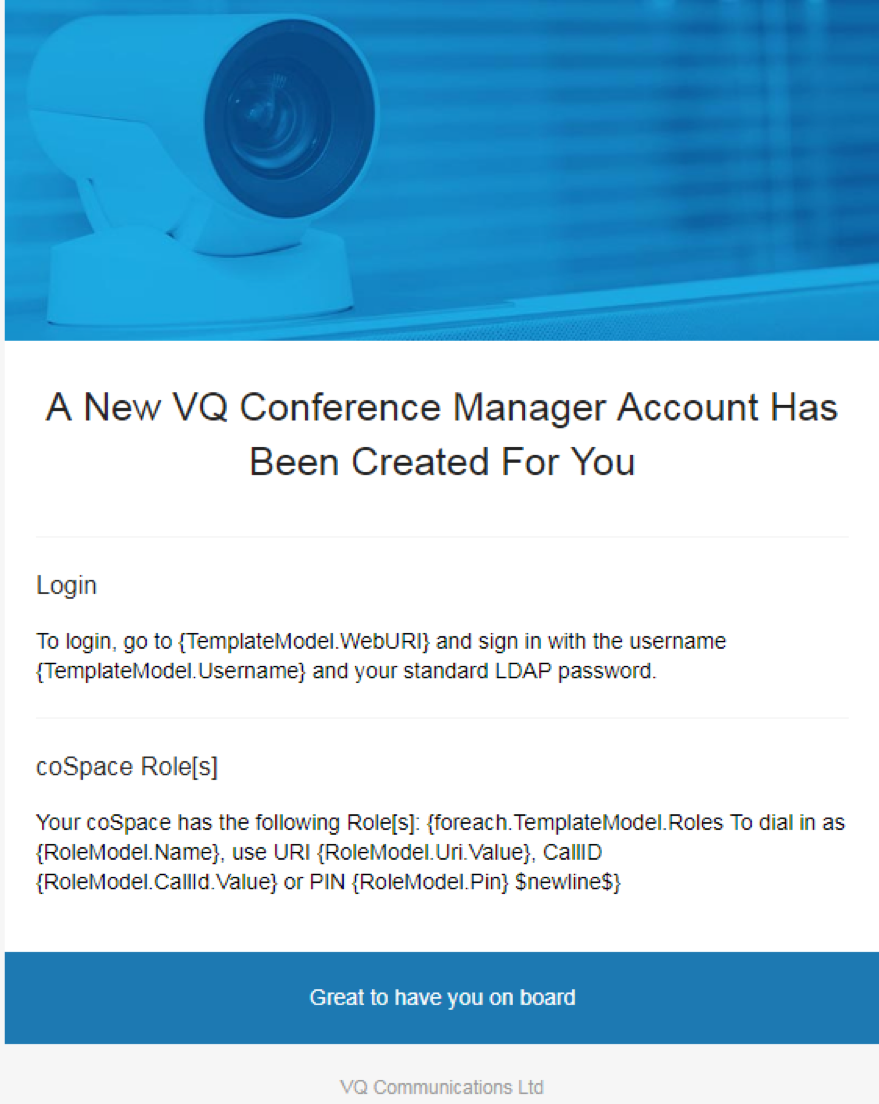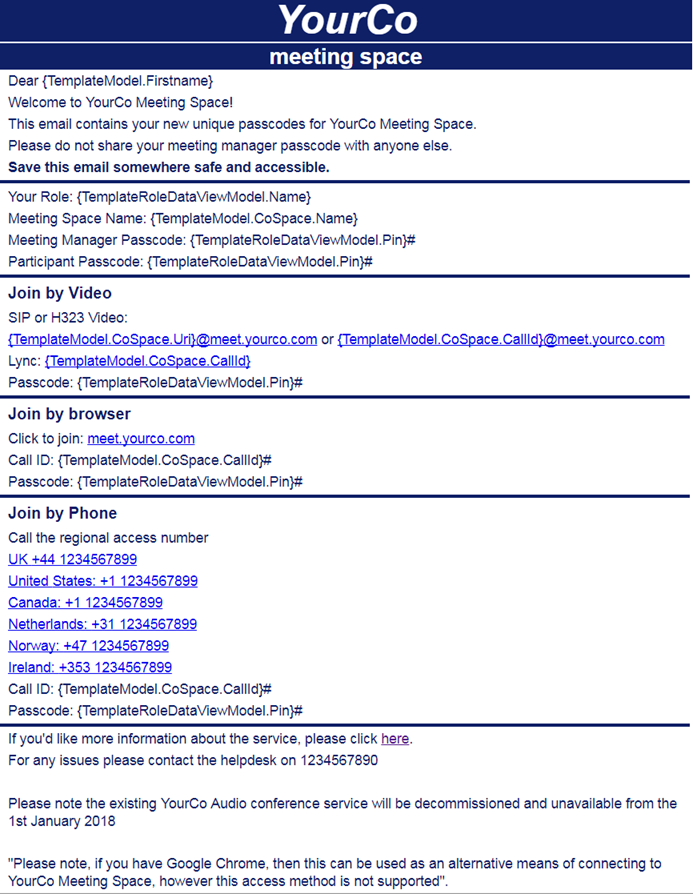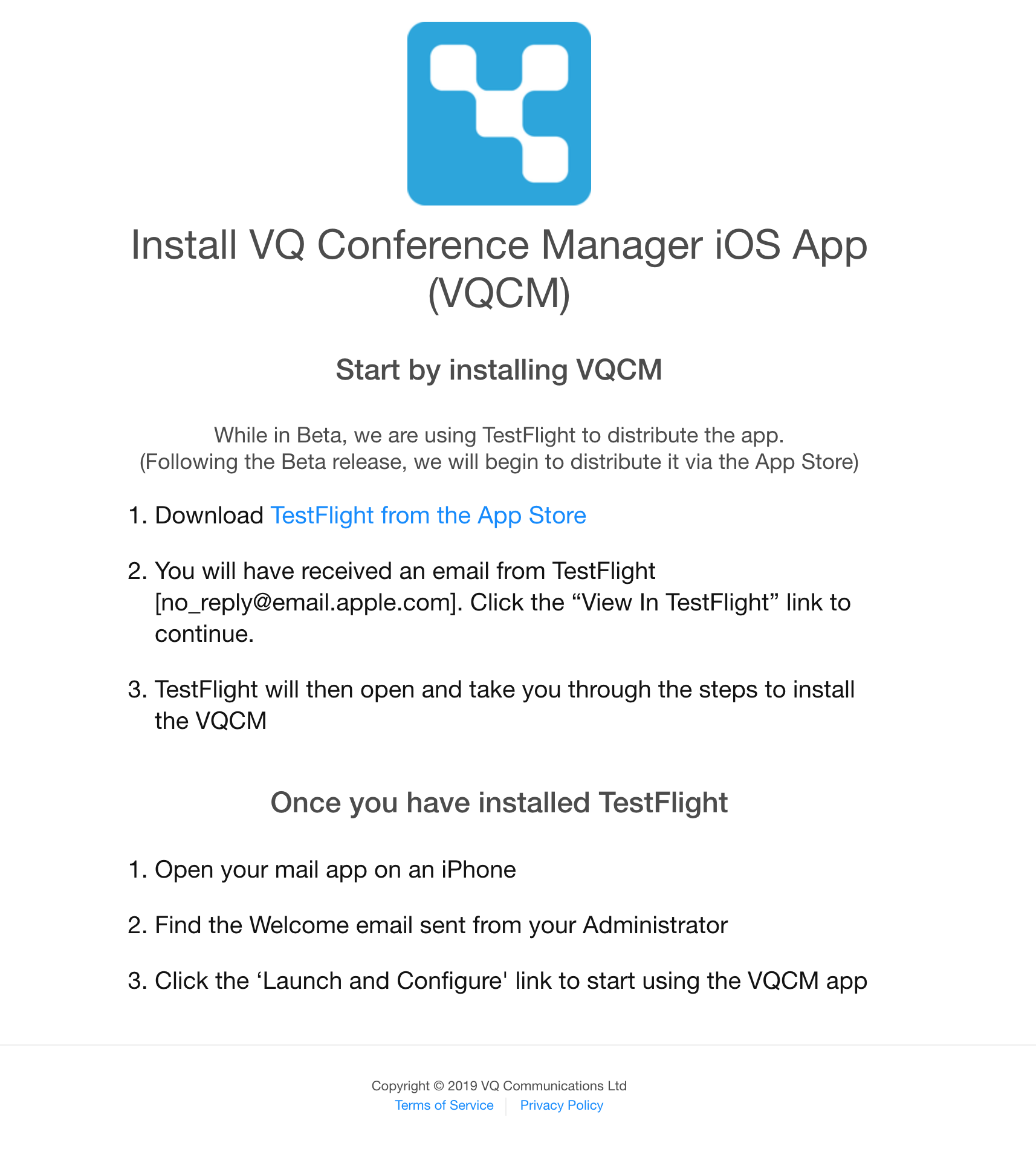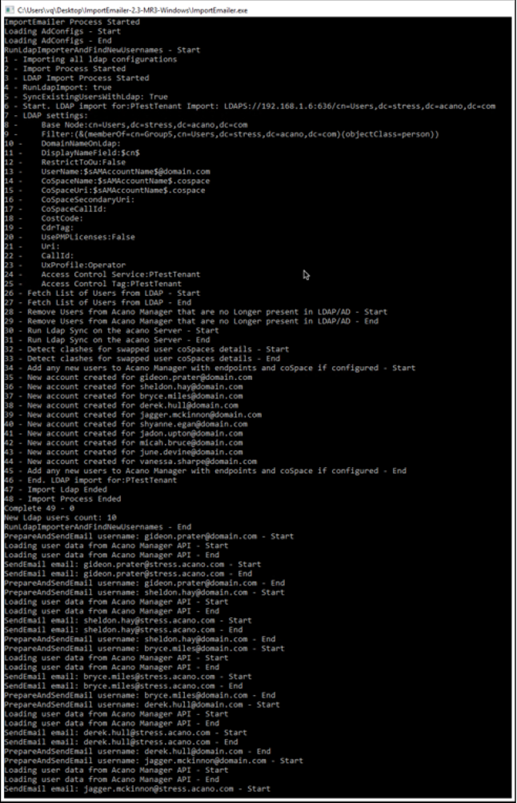Import Emailer
ImportEmailer is a tool that enables you to import users from LDAP and, for each new user, send a provisioning email containing details of how to access the service, their account name and credentials plus details for their Space (URI, Secondary URI, PIN/Passcode).
It is a very useful tool and enables the fully automated provisioning of new users. We have been using it very successfully with an initial set of early adopters and it has helped them host very successful deployments.
Contacting Support
CAUTION: We strongly recommend that the first time you use this tool, you do so under guidance from support@vqcomms.com
Running ImportEmailer
|
|
Installing ImportEmailer
Download ImportEmailer (VQCM 3.12.x) from vqcomms.com.
The tool can be downloaded and executed from a Windows system. The ImportEmailer connects to your VQ Conference Manager instance via VQ Conference Manager's REST API. You will need authentication details for an Administrator user on VQ Conference Manager.
Usage
|
|
Remember to run the tool with Administrative rights (Right click "run as administrator").
ImportEmailer picks up its settings from a configuration file "config" located in the same folder as ImportEmailer.
{
"VQCM": {
"Fqdn": " vqcm.mydomain.com ",
"Https": true,
"Authorization": {
"LoginFqdn": "login.vqcm.mydomain.com",
"Https": true,
"Client": {
"ClientId": "myClientId",
"Secret": "squirrel"
}
}
},
"Settings": {
"ImporterTestMode": false,
"DisableEmails": false,
"TenantId": 3,
"LdapConfigs": [ "Ldap group name 1" , "Ldap group name 2"],
"LogsDirectory": "./logs",
"EmailTemplatePath": "./EmailTemplate.html",
"EmailSettings": {
"FromAddress": "noreply@domain.com",
"FromName": "From Text",
"Subject": "Subject Text"
},
"SMTP": {
"Host": "smtp.xxx.xxx",
"Port": 25,
"Username": "email user",
"Password": "Account password"
}
}
}
|
VQ Conference Manager |
Description |
Notes |
|---|---|---|
| Fqdn | The FQDN for VQ Conference Manager. | |
| LoginFqdn | The FQDN for VQCM's Identity Server | |
| ClientId | The Client Id in VQCM-Admin | |
| Secret | The Secret configured in VQCM-Admin |
|
Settings |
Description |
Notes |
|---|---|---|
| ImporterTestMode | Allows the tool to run the importer without adding/deleting any users. |
If this setting is enabled, the tool will run the Importer in Test Mode, similarly to the functionality in the CM UI. This will report on what changes would be done by the import, without actually applying any changes. Valid values; 'true' or 'false'. |
| DisableEmails | Allows for the tool to be run without sending emails. |
If this setting is enabled, the tool will run without sending emails. It will still perform the import and create users into VQ Conference Manager. This is not a Test Mode. Valid values; 'true' or 'false'. |
| LdapConfigs |
The LdapConfigs parameter defines the LDAP Configuration name (or names) to be used. |
Multiple AD/LDAP Configuration names can be selected. If required, separate each name by a comma e.g., [Bigco LDAP (Operators),Bigco LDAP (Users)] If you had a single AD/LDAP Config of Bigco LDAP (Operators), you would enter [Bigco LDAP (Operators)]. |
| LogsDirectory | The relative path to the folder location for log files. Defaults to the folder containing the ImportEmailer executable. | |
|
EmailTemplate Path |
The relative path to the folder location containing the 'EmailTemplate.html' file. Defaults to the folder containing the ImportEmailer executable. | The EmailTemplate.html file can be customized to meet your needs. We do caution against changing it too much. The default file has been tested with all Outlook versions and works; Outlook's HTML rendering is limited. |
|
Email Settings |
Description |
Notes |
|---|---|---|
| FromAddress | The 'From' address to be used in each email. | |
| FromName | The 'From' name to be used in each email. | |
| Subject | The 'Subject' to be used in each email. |
|
SMTP |
Description |
Notes |
|---|---|---|
| Host | The Host name/IP address of your SMTP server. | |
| Port | The TCP/IP port to use. | The default SMTP port is 25. |
| Username | SMTP user server name. | This will always be false on the VM Appliance version. |
| Password | SMTP server user password. |
HTML Template
The HTML Email referenced by the configuration settings is mailed our for each new user created.
The file included as part of the package was designed to work with all versions of Outlook. It has been tested against each version and, despite some minor variations in detail, renders successfully.
We council against modifying the file too much unless you have plenty of experience with how HTML renders in the different flavors of Outlook.
The tool replaces the text in curly braces "{.....}" with values from VQ Conference Manager User name, URI and Pin/passcode values etc.
Each new user created will be sent a copy of the Email.

Or alternatively, here's another example:

A second example template has been added (iOS Email Template) that includes an automatically iOS configuration link:


Spamming considerations
Please check with your mail service provider and check for any spamming protection the service might be running.
If you are only provisioning a relatively small number of new users, you shouldn't face any issues. However, if you are provisioning thousands or even tens of thousands of users, that might trigger a spamming alarm.
How to find the values for "LdapConfigs"
Apologies in advance. This requires some manual work with the user interface.
- Login to VQ Conference Manager as an Administrator
- Click on Tenants and then select the Tenant containing the users whose Spaces are to be checked
-
The AdConfig value you need is name of the LDAP Configuration(s) as shown below

Example output
Note: The user names in the following output examples are examples from a randomly generated test data set.

Running the tool automatically on a daily basis
In the same way that the regular LDAP Importer can be run on regular bases, the ImportEmailer can be run from the Windows Task Scheduler at pre-defined times and/or dates.
Please download the Automated LDAP Import document from the Customer Portal at vq.comms.com.
Automatically renaming log files
For information on how to rename a logfile.txt file to add a date/time, or to automatically delete old log files, please read the Automatically Renaming Log files document, available from vqcomms.com.
Getting help running this tool
Please do not hesitate to contact our support team at support@vqcomms.com for help running this tool.

